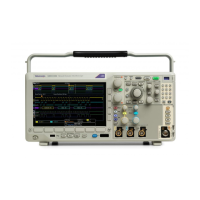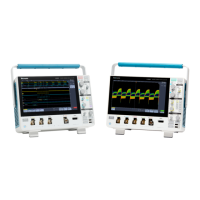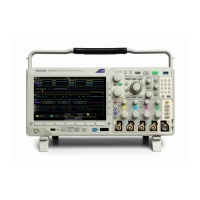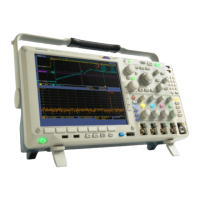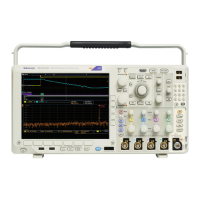
Do you have a question about the Tektronix MDO3054 and is the answer not in the manual?
| Brand | Tektronix |
|---|---|
| Model | MDO3054 |
| Category | Test Equipment |
| Language | English |
Summarizes essential safety precautions for operating the oscilloscope and connected equipment.
Details precautions related to power cords, grounding, and proper connection/disconnection.
Warns against touching exposed components and using damaged equipment.
Safety guidelines for using probes and test leads, including voltage ratings and inspection.
Details electromagnetic compatibility standards and directives the instrument adheres to.
Lists safety standards and testing laboratory listings the product meets.
Highlights the main functionalities and capabilities of the MDO3000 series oscilloscopes.
Lists available software modules that extend the oscilloscope's functionality.
Describes available upgrades, such as bandwidth upgrades, that can be purchased post-purchase.
Provides detailed steps for powering on the oscilloscope, including grounding procedures.
Explains the importance of grounding for safety and accurate measurements.
Details the procedure for powering off the oscilloscope and disconnecting the power cord.
Explains the automatic probe compensation procedure for specific Tektronix passive probes.
Describes how to compensate passive voltage probes not covered by the automatic procedure.
Provides instructions and precautions for installing application modules, including ESD warnings.
Guides users on how to purchase and install bandwidth upgrades for higher performance.
Details the procedure for compensating the signal path for both time and frequency domains.
Explains how to confirm the firmware version after the upgrade process.
Explains methods for connecting the oscilloscope to a computer for data analysis and control.
Describes using VISA drivers for data acquisition and communication with PC software.
Explains how to access and control the oscilloscope via a web browser using e*Scope.
Covers network configuration and password protection for the e*Scope interface.
Guides on how to use the Autoset function for automatic instrument setup.
Explains FastAcq for high-speed waveform capture, useful for transient events.
Describes how to configure the oscilloscope to perform actions based on defined events.
Guides on setting up serial and parallel bus triggering and parameter configuration.
Explains how to set bus parameters, including bus type, define inputs, and thresholds.
Guides on connecting and configuring the P6316 logic probe for digital signal acquisition.
Guides on enabling and using MagniVu for enhanced timing analysis.
Explains how to configure RF input parameters for frequency domain measurements.
Details setting the center frequency and span for spectrum analysis.
Explains how to adjust the RF amplitude reference level for spectrum analysis.
Explains resolution bandwidth (RBW) and its impact on frequency resolution and noise floor.
Explains the choice of FFT window types for trade-offs in resolution and accuracy.
Introduces concepts and procedures for setting up triggers to capture specific signal events.
Guides on selecting and setting up various trigger types available on the oscilloscope.
Explains how to trigger on multiple data buses, including parallel buses, with application modules.
Guides on starting and stopping waveform acquisition using Run/Stop and Single buttons.
Covers concepts and procedures for displaying acquired waveforms or trace data.
Introduces waveform analysis features like cursors, measurements, math, and FFT.
Guides on taking automatic measurements like frequency, period, rise/fall time, and pulse width.
Guides on taking automatic measurements in the frequency domain, such as channel power and occupied bandwidth.
Explains how to use the digital voltmeter to measure potential difference between two points.
Introduces Wave Inspector controls for efficient work with long record length waveforms.
Guides on monitoring signals against masks, creating custom masks, and running tests.
Explains how to use the MDO3PWR Power Analysis Module for power signal analysis.
Covers saving and recalling setups, waveforms, and screen images using internal or external storage.
Explains security features like password protection and memory erasure.
Introduces the optional integrated arbitrary function generator (AFG) for signal simulation.
Introduces optional application modules that extend oscilloscope capabilities.
Lists modules like MDO3PWR (Power Analysis) and MDO3USB (Serial Triggering/Analysis) with their features.
Summarizes safety precautions for probe usage, connection, and terminal ratings.



